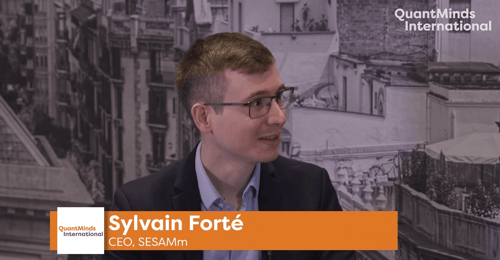Barcelona, QuantMinds International, November 2022
CEO Sylvain Forté joins QuantMinds correspondent Joanna Simpson in an interview highlighting the use of AI in ESG Investing and how we use it to detect greenwashing practices.
Below is an approximation of this video’s audio content. Watch the video for a clearer understanding of the topics discussed during the interview.
Joanna: I'm Joanna Simpson here at QuantMinds International in Barcelona. Joining me now is Sylvain Forté, CEO of SESAMm. Thank you very much for being here.
Sylvain: Thank you.
Joanna: Tell me, how does it feel to be here at QuantMinds International?
Sylvain: It feels very good, actually. We've been to the conference a couple of times already, so it's not our first year, and this time we brought several people from our team. We're all here together, presenting our technology and discussing some of the novelties in the space. It's very exciting and personalized.
Joanna: Great. And what role does artificial intelligence have to play in the future of ESG and ESG investing, in particular?
Sylvain: ESG is a massive trend in the industry right now, not just in asset management and the quant space but also in private equity, in corporate space like tracking suppliers, clients, etc. And one of the key problematic themes that we see is data gaps. There's a lack of data in terms of coverage; small caps, mid caps, or even private firms are not well covered. The frequency of information tends to be lagging. There's a very low frequency, like quarterly updates or so. There's also a lack of transparency and the like.
So, I believe that AI is primarily a tool that can help build that information gap and, for example, cover millions of companies instead of just a few tens of thousands of companies manually. What we do at SESAMm is leverage a technology called natural language processing (NLP), where we screen text automatically to understand potential ESG controversies or positive impact events. This leads us to have a coverage of around 5 million companies, meaning every publicly listed company out there and private firms that no one else would cover otherwise. This enables many use cases.
There's also frequency; you can generate indicators every single day, more like a quantitative time series that people are used to, and this enables clients to get access to information even locally, like Raiffeisen, one of our clients, is tracking clients in Poland, in Austria, in Germany, or in Ukraine using NLP which would not be possible with traditional ESG metrics. I think that the key topic of AI is expanding the use, expanding the coverage in terms of ESG data, and making sure that data is systematic, follows a good process, and is transparent.
Joanna: What examples are there of ESG investing being enhanced by AI?
Sylvain: We see two primary use cases.
The first one is more quantitative, where people are looking to leverage ESG NLP data in their systematic trading process. It's either for alpha generation; for example, we work with LFIS, an asset manager in France that created a fund based on ESG NLP data. Their primary goal is to enhance their strategy to generate outperformance, which is really a good use case in that space. This is the quantitative use case where you can use higher frequency data like daily data to leverage ESG like any other kind of alternative dataset and derive superior returns.
Then we have more discretionary use cases where we see large asset managers or private equity shops which are looking to perform risk management tasks or help their team prioritize the scoring of assets. Say they have a team that does their own proprietary scoring on assets with regards to ESG, but how do I prioritize? I have 3000 assets to follow, I need some kind of alert on that whole universe to make sure that I focus on the assets that could be most controversial today. That's one of the things that we provide; daily alerts using natural language processing where people can say okay, there is a massive shift right now; as an ESG analyst, I'm going to make a decision to look at this asset specifically to help cover it and update the score.
Joanna: Can AI help with greenwashing in ESG investing, and if so, how?
Sylvain: Yes, it's one of the other kinds of problems that you have in ESG is the lack of transparency on the methodology creates some anomalies in some cases. And one of the big anomalies is that there's this averaging effect where a firm that has both positive actions and negative topics is going to be, on average, neutral, which is really problematic.
We had a big example like this in France recently with Orpea, a listed company of nursing homes exposed to a massive scandal with regards to mistreating patients—so more like social washing than greenwashing. And the problem is their scores were pretty high because, at the same time, they had some positive impact. They were implementing new diversity policies and the like, so it was averaging up.
At SESAMm, we leverage NLP to completely differentiate positive and negative topics. So if a firm is doing good stuff that is aligned with SFDR, and they have positive actions, etc., great! That's going to be one score. But if, at the same time, they have very negative topics, there are a lot of risks we're going to still detect that's not going to be averaged. It's going to be very specifically focused on.
Joanna: Sylvain Forté, thank you for your time.
Sylvain: Thank you very much.
To learn more about how SESAMm uses TextReveal to find ESG data, contact a representative today.

